Soil Conservation Program
The Soil Conservation Program at the Plant Materials Center leads conservation projects and provides plant science expertise and technical assistance to government agencies, contractors, land users and the general public for the protection of soil resources.
PMC Programs
- PMC Home Page
- Horticulture
- Industrial Hemp
- Invasive Plants
- Plant Pathology
- Potatoes
- Potato Program
- Certified Seed Potato Production
- Disease Risk Monitoring
- Publications and Reports
- Late Blight Management Plan for Alaska, 2005
- AK Seed Potato Certification Handbook, 2017
- 2018 AK Certified Seed Potato Growers
- 2018 Potato Postharvest Processing Evaluation Report
- 2013 Potato Variety Trial Project
- 2015 Field Potato Evaluation
- 2016 Potato Germplasm Winter Grow Out
- Download .zip video of 2014 Potato Symposium Meeting
- Resources
- Revegetation
- Seed Production
- Soil Conservation
- Publication List
- Native Plant Source Directory
- PMC Staff Directory
- PMC Weather Station

5310 S Bodenburg Spur
Palmer, AK 99645
Phone: 907-745-4469
Fax: 907-746-1568
Mon. - Fri.
8 a.m. - 4 p.m.
Click Map For Directions
View Larger Map
What is Erosion?
Erosion is the detachment and movement of soil particles, rock fragments or solids, by the action of wind, water, ice or gravity.
Why is Erosion a Problem?
Erosion is a problem that growers, contractors, engineers and other industry professionals have faced for decades. The process of erosion not only causes soil and nutrient loss, but it can also cause sediment loading of stream channels, which have major impacts on fisheries and plant ecosystems.
In a natural setting the process of erosion is fairly slow and gradual. When vegetation is removed, top soil is stripped, the surface becomes compacted, thereby increasing the discharge rate. In some cases there can be 300 times more stormwater runoff, creating a more disturbed site than would occur naturally. This is further exacerbated by other factors that influence erosion such as soil texture, precipitation, slope gradient and surface area. In a developed area, erosion can be 1,000 times greater. Increased sediment transport and the resulting erosion can cause significant impacts to the economy, human health and the environment.


Types of Erosion
- Raindrop
- Sheet
- Rill
- Gully
- Stream & Channel Bank
Raindrop
The movement of soil particles caused by the direct impact of raindrops on bare soil.
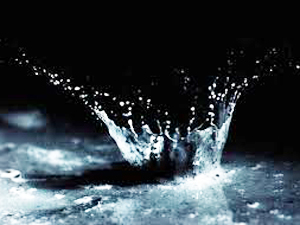
Sheet
The action of water runoff over the ground surface as a thin, even layer.
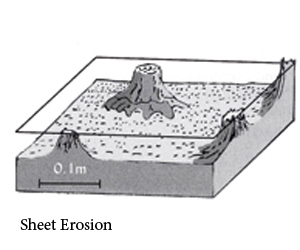
Rill
A small, intermittent water course with steep sides, usually only a few inches deep.

Gully
A channel caused by concentrated flow of surface water runoff over unprotected soil.
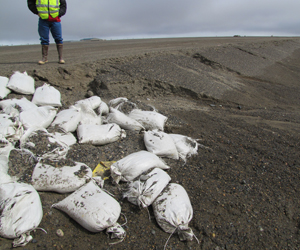
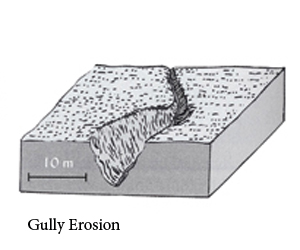
Stream & Channel Bank
Bank and bed erosion of an existing stream channel generally caused by increased peak flows.
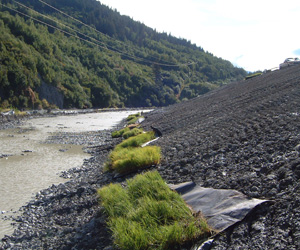
Types of Sediment Transport by Water and Wind
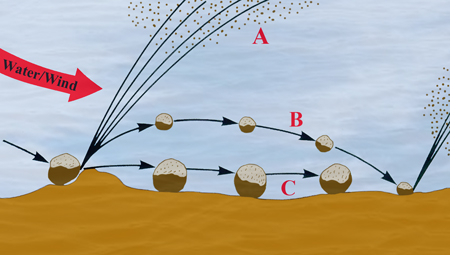
By Water:
A: Colloidal Suspension – Same as suspension, but is only the suspension of very fine particles, such as clay.
B: Suspension – Soil particles that are lifted by the energy flow of water and moved downstream before settling out.
C: Bed Load – Soil particles that are dragged, rolled or skipped.
By Wind:
A: Suspension – Small sized particles such as silt or clay that become entrained in the wind and may remain in suspension for hours or even days.
B: Saltation – Medium sized particles such as sand that are dragged, rolled or saltated by wind.
C: Creep – Larger particles such as rocks and gravel that are rolled, pushed or that slide along the ground.
What is Erosion and Sediment Control?
Erosion control is the practice of preventing or controlling wind or water erosion in agriculture, land development and construction. Effective erosion control techniques are important in preventing water pollution and soil loss.
Sediment control is a practice or device designed to keep eroded soil on site, so that it does not wash off and cause water pollution to a nearby stream, river, lake or sea.
Soil is a valued resource that must be conserved in place for future generations.
For More Information Contact:
Casey Dinkel
Agronomist
Soil and Erosion Control Specialist
907-745-8108
Email casey.dinkel@alaska.gov
